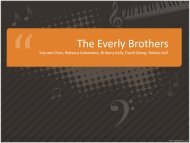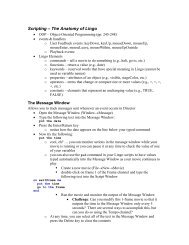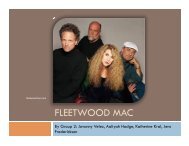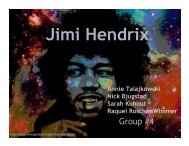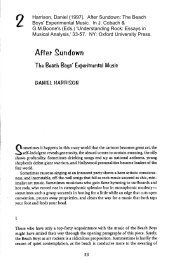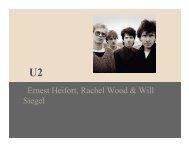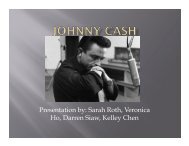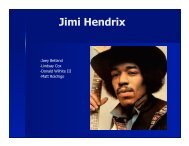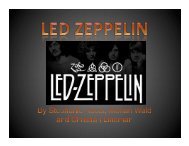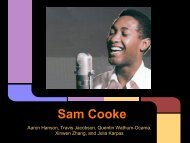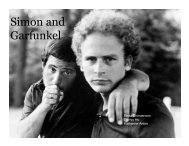final presentation - group 2 - otis redding.pptx - Scott D. Lipscomb
final presentation - group 2 - otis redding.pptx - Scott D. Lipscomb
final presentation - group 2 - otis redding.pptx - Scott D. Lipscomb
Create successful ePaper yourself
Turn your PDF publications into a flip-book with our unique Google optimized e-Paper software.
O"s Redding <br />
h,p://thehoboride.blogspot.com/2011/12/this-‐day-‐in-‐rock-‐history-december-‐10.html
Early Life <br />
• O"s Redding was born <br />
on Sept 9 th , 1941. <br />
• He is from Dawson, <br />
Georgia. <br />
• He dropped out of <br />
school at the age of 15, <br />
in order to support his <br />
family by working for <br />
other musicians and <br />
singing at talent shows <br />
• (O"s <strong>redding</strong>) <br />
h,p://www.soulwalking.co.uk/O"s<br />
%20Redding.html
Early Career <br />
h,p://addictedtovinyl.com/blog/2009/08/14/new-‐o"s-<strong>redding</strong>-‐best-‐of-‐due-‐from-‐shout-‐factory-‐on-‐october-‐20th/<br />
<br />
• He started off his <br />
musical career by <br />
working with Li,le <br />
Richard’s band, The <br />
Upse,ers <br />
• A few years later, he <br />
started working with a <br />
different band, The <br />
Pinetoppers <br />
• (O"s <strong>redding</strong>)
His Big Break <br />
• While working with the Pinetoppers, Redding <strong>final</strong>ly <br />
got his big break. <br />
• He signed with Stax Records and released his first <br />
solo album on Jan. 1 st , 1964. <br />
• His songs included “Pain In My Heart”, “(Sibn’ On) <br />
The Dock of the Bay”, and “These Arms of Mine” <br />
• He was inducted into the Rock ‘n Roll Hall of Fame in <br />
1989 <br />
• (O"s <strong>redding</strong>)
Death <br />
• On Dec. 10 th , 1967, the <br />
plane carrying O"s <br />
Redding and his back up <br />
band crashed into Lake <br />
Monona on their way to <br />
Madison, WI. <br />
• Even though his career <br />
was short, Redding <br />
made a huge impact on <br />
the musical world. <br />
• (O"s <strong>redding</strong>) <br />
h,p://portalwisconsin.wordpress.com/<br />
2010/12/06/the-‐day-‐o"s-‐<strong>redding</strong>-dieddecember-‐10-‐1967-‐lake-‐monona-‐wi/
Musical Style <br />
• Vocal talent <br />
– O"s had an intriguing voice that “created a new <br />
emo"onal standard for southern soul” <br />
• Band <br />
– He was backed by one of the best rhythm sec"ons <br />
in history; Booker T. & the M.G.’s
Musical Style (cont.) <br />
• No backing vocals <br />
– Started the use of horn dialogue, in place of <br />
tradi"onal backing vocals, for call-‐and-‐response <br />
segments <br />
• The King of Soul <br />
– Music was filled with vocal melismas, extended <br />
periods of interpola"on, and improvisa"on <br />
– O"s had a strong connec"on with the music
Performance Style <br />
• Stage fright <br />
– O"s never got over his stage fright, and it would <br />
show during his performances <br />
– He would prac"cally freeze from the waist down
Performance Style (cont.) <br />
O"s and The Bar Keys <br />
h,p://moonjunk.tumblr.com/post/<br />
10445700307/o"s-‐<strong>redding</strong>-‐and-‐his-‐backing-‐band-the-‐bar-‐keys<br />
<br />
• Band leader <br />
– The band members <br />
were all friends of <br />
O"s and would <br />
always have fun on <br />
stage together <br />
– O"s was able to <br />
command the band <br />
just by reac"ng <br />
powerfully to the <br />
music
Performance Style (cont.) <br />
• Audience <br />
– He loved to make a connec"on with his audience <br />
– Constantly aware of the listener, and constantly <br />
interac"ng
• Li,le Richard <br />
– Went on tour with Li,le <br />
Richard <br />
– His inspira"on and idoliza"on <br />
gave O"s Redding a style <br />
imita"ng Li,le Richard in his <br />
youth <br />
– Later, his idol Li,le Richard <br />
inducted him into the Rock <br />
and Roll Hall of Fame <br />
• Sam Cooke <br />
– Sam Cooke’s dis"nc"ve <br />
trademark high notes are <br />
found in much of O"s <br />
Reddings’ music <br />
Main Influences <br />
• (Shmoop Editorial Team, 2008; <br />
Brennen, 2008) <br />
Li,le Richard <br />
h,p://www.imdb.com/name/nm0005153/
Other Influences <br />
• Eric Clapton <br />
• Jimi Hendrix <br />
• Both can be heard in his <br />
later more rock and roll <br />
works like “Hard to <br />
Handle” <br />
• (Gulla, 2007) <br />
Jimi Hendrix <br />
h,p://www.rollingstone.com/music/ar"sts/jimi-hendrix
Influenced by O"s Redding <br />
• Almost all other soul singers of the 1960’s were <br />
influenced by O"s Redding <br />
• He is omen referred to as “The King of Soul” because <br />
of his strong original influence <br />
• There are many ar"sts that feature covers of his <br />
work <br />
– Aretha Franklin, The Doors, Pearl Jam, Kelly Clarkson, Willie <br />
Nelson, Al Green, Kanye West, The Black Crows, and many more <br />
• (Shmoop Editorial Team, 2008; Brennen, 2008)
Influenced by O"s Redding (cont.) <br />
• His sons Dexter and O"s <br />
III also went into music <br />
forming the Reddings <br />
• Came out with a Top 10 <br />
R&B song called <br />
“Remote Control” <br />
• Consider their father a <br />
great inspira"on <br />
• (Shmoop Editorial Team, 2008; <br />
Brennen, 2008) <br />
The Reddings <br />
h,p://www.cdandlp.com/item/<br />
2/36918-‐220204-‐0-‐1-‐0/115371016/the-‐<strong>redding</strong>s-‐if-looks-‐could-‐kill.html
Style and Fit <br />
• Music of the 1950’s and early 1960’s consisted mainly of <br />
white males. There were very few female ar"st/<strong>group</strong>s <br />
who were popular at that "me. The Bri"sh Invasion of <br />
the 1960’s, the emergence of Motown Records, and the <br />
evolving nature of Rock and Roll during this period would <br />
see ar"st become more experimental, innova"ve and <br />
risky with their music. <br />
• During this "me period the roots of rock and roll(Pop, <br />
C&W, and R&B) and the emergence of the basic rock and <br />
roll styles (Mainstream, Rockabilly, and Som Rock) were <br />
the popular genres. <br />
• Folk, Country, and Blues s"ll remained relevant
Musical Style of the 1960’s <br />
h,p://thebeatlesautographs.net/ <br />
h,p://www.eonline.com/celebs/Elvis_Presley/<br />
110703 <br />
h,p://www.britannica.com/<br />
EBchecked/media/102011/<br />
The-‐Supremes-‐late-‐1960s <br />
• Some of the top ar"st <br />
during the 1960’s <br />
include: <br />
– The Beatles <br />
– Elvis <br />
– Beach Boys <br />
– Ray Charles <br />
– Rolling Stones <br />
– Supremes <br />
– The Byrds <br />
– Bob Dylan <br />
– 4 Seasons <br />
– Sam Cooke
Musical Style of the 1960’s (cont.) <br />
• O"s’ simple style followed some characteris"cs of ‘soul <br />
music’ during the era and managed to stay uncomplicated. <br />
Although influenced by ar"st like Li,le Richard, Sam Cooke <br />
and even the Beatles (Si#ng on the Dock of the Bay), O"s <br />
preferred the successful formula of simple, blues <br />
influenced ‘soul music’. <br />
– “Basically, I like any music that remains simple and I feel this is <br />
the formula that makes 'soul music' successful. When any music <br />
form becomes clu,ered and/or complicated you lose the <br />
average listener's ear. There is nothing more beau"ful than a <br />
simple blues tune. There is beauty in simplicity whether you are <br />
talking about architecture, art or music.” (1) – Soul Magazine
Social Influences <br />
• Civil Rights Movement <br />
– The Civil Rights Movement was a <br />
movement sustained by music. <br />
– Provided ar"st such as O"s the opportunity to pursue <br />
business ventures and live the ‘American Dream’ <br />
• Owned O"s Redding Enterprises. <br />
• Through performances, music publishing, royal"es and <br />
record sales, he earned more than a million dollars in 1967 <br />
alone (2) <br />
• Counterculture Movement <br />
– Movement driven by youth, produced a market for <br />
rock, soul, pop, reggae and blues music.
Social Influences-‐People <br />
• There was a constant threat <br />
against the lives of blacks <br />
and those supported <br />
change, from black and <br />
white dissenters <br />
• Dr. Mar>n Luther King Jr <br />
– “I Have A Dream” Speech promoted <br />
social unity <br />
• John F. Kennedy <br />
– Elec"on changed the poli"cal <br />
dynamics of the country <br />
– Assasina"on <br />
• Medgar Evers <br />
– NAACP field secretary. Assassinated <br />
by a member of the Ku Klux Klan in <br />
Jackson, Mississippi. <br />
• Malcolm X <br />
– Assassina"on <br />
Mar"n Luther King Jr. <br />
h,p://muslimma,ers.org/2011/03/03/<br />
what-‐does-‐the-‐civil-‐rights-‐movement-mean-‐for-‐muslims/
Poli"cal Influences <br />
h,p://www.boomerslife.org/<br />
protests_rally_iran_neda_agha_soltan.htm <br />
• Vietnam War <br />
– An"-‐war movement <br />
par"cipants provided <br />
inspira"on to much of the <br />
music during the 1960’s <br />
– Dram <br />
• Manager, Phil Walden and <br />
brother, Rodgers Redding <br />
were both dramed. <br />
• Threats of War <br />
– Cold War <br />
– Made travel strenuous and <br />
at "mes difficult
Musical Analysis <br />
• The song that we chose to do our musical analysis on <br />
is “(Sibn’ On) The Dock of the Bay <br />
• We chose this song because it became a number one <br />
hit on both the Pop and R&B charts amer O"s <br />
Reddings’ death
Musical Analysis <br />
Instrumenta"on <br />
• Instrumenta>on: The instruments that we hear used <br />
in this par"cular song would be the drums, acous"c <br />
guitar, bass guitar, what sounds like a piano or a <br />
keyboard, and then there are some brass instruments <br />
like a saxophone (I think it might actually be a <br />
trombone)and trumpets. <br />
• There are also some parts where I hear an electric <br />
guitar as well <br />
• The whistling of O"s Redding is also an <br />
instrumenta"on in itself <br />
• There is also some non-‐musical instrument sounds like <br />
the whooshing sound of water at the very beginning of <br />
the song to represent waves
Musical Analysis <br />
Meter and Beat Subdivision <br />
• Meter: The meter of this song would be <br />
quadruple meter or duple meter. <br />
– There are four beats per measure. <br />
• Beat Subdivision: The beat subdivision in this <br />
song would be a duple subdivision. It’s <br />
difficult to hear but if you listen closely to the <br />
drums you can pick up on it.
Musical Analysis <br />
Texture and Form <br />
• Texture: The texture of this song is definitely <br />
homophonic melody and accompaniment. I feel <br />
it is this because it is the singer only being <br />
accompanied by musical instruments and no <br />
back-‐up singers. <br />
• Form: The form is AABA. The B is actually 3 <br />
stanzas, so it sounds like AABACAA if you’re <br />
actually listening for different part feelings, but I <br />
think the idea in AABA is that there is an altered <br />
a,en"on grabbing por"on somewhere in the <br />
middle, so it would fit with the categoriza"on.
Legacy <br />
• Much of Stax Records’ success lies in the work of O"s <br />
Redding <br />
• Originally recorded country and rockabilly music <br />
• Following his success there, Stax added “Soulville, <br />
USA” to its "tle
Legacy (cont.) <br />
• O"s Redding had a profound influence on the history <br />
of soul music, as well as rock and roll <br />
• Named “The King of Soul” <br />
• Rolling Stones covered two of his songs <br />
• In 1989, he was <strong>final</strong>ly inducted into the Rock and Roll <br />
Hall of Fame <br />
• Jay-‐Z and Kanye West’s song, “O"s,” was Grammy <br />
nominated for best rap song in 2011
Resources <br />
• Brennan, C.(2008). "Cooke, Sam 1931—1964." Contemporary Black Biography. Retrieved <br />
June 25, 2012 from Encyclopedia.com: <br />
h,p://www.encyclopedia.com/doc/1G2-‐2871900023.html <br />
• "Eyewitness Tells of O"s Redding's Violent Death". Jet. December 28, 1967. <br />
• Gulla, B. (2007) “O"s Redding.” Icons of r&b: An encyclopedia of the ar"sts who <br />
revolu"onized rhythm (Vol. 1, pp. 412). Ann Arbor, MI: Greenwood Press. <br />
• Guralnick, Peter (1999). <br />
Sweet Soul Music: Rhythm and Blues and the Southern Dream of Freedom. Back Bay Books. <br />
• Hirsch, E.D. (1993). The DicBonary of Cultural Literacy. Houghton Mifflin. <br />
• Labrie, Peter (April 1968). "The Flame That Died". Black World/Negro Digest. <br />
• OBs <strong>redding</strong>. (n.d.). Retrieved from h,p://rockhall.com/inductees/o"s-‐<strong>redding</strong>/bio/ <br />
• OBs <strong>redding</strong>. (n.d.). Retrieved from h,p://www.crecon.com/davidwomack/o"s <strong>redding</strong>.htm <br />
• Ritz, D. (2012). OBs <strong>redding</strong>. Retrieved from <br />
h,p://www.britannica.com/EBchecked/topic/494636/O"s-‐Redding <br />
• Scaruffi, P. (2005). A brief history of soul music. Retrieved from <br />
h,p://www.scaruffi.com/history/soul.html <br />
• Sco, Freeman, OBs!: The OBs Redding Story (New York: St. Mar"n's Griffin Press, 2001); <br />
Rhino Records, Los Angeles, OBs!: the definiBve OBs Redding [sound recording], (1993). <br />
• Shmoop Editorial Team (November 11, 2008).OBs Redding Influences. Retrieved June 25, <br />
2012, from h,p://www.shmoop.com/dock-‐of-‐the-‐bay/influences.html <br />
• Whatman, R. (2006, May 26). OBs <strong>redding</strong>: Living at the apollo november 1963. Retrieved <br />
from <br />
h,p://browneyedhandsomeman.blogspot.com/2006/05/o"s-‐<strong>redding</strong>-‐live-‐at-‐apollo-november.html



